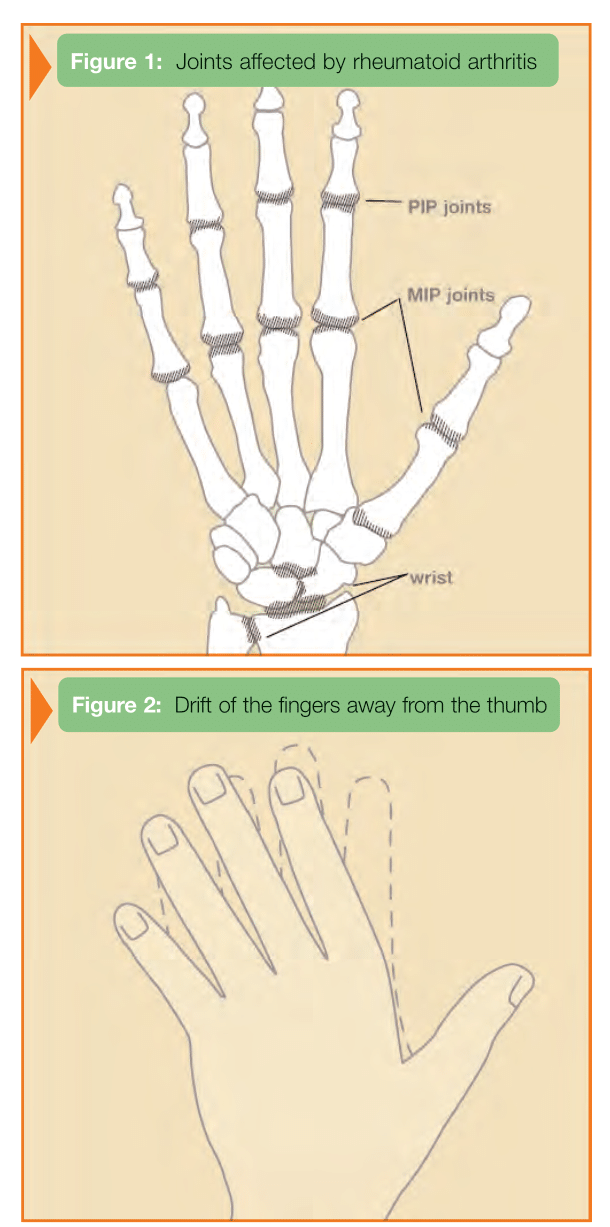Rheumatoid Arthritis of the Hand
Rheumatoid Arthritis of the Hand
 What is it?
What is it?
Arthritis literally means “inflamed joint.” Normally a joint consists of two smooth, cartilage-covered bone surfaces that fit together as a matched set and that move smoothly against one other. Arthritis results when these smooth surfaces become irregular and don’t fit together well anymore and essentially “wear out.” Arthritis can affect any joint in the body, but it is most noticeable when it affects the hands and fingers. Each hand has 19 bones, plus 8 small bones and the two forearm bones that form the wrist. Arthritis of the hand can be both painful and disabling. The most common forms of arthritis in the hand are osteoarthritis, post-traumatic arthritis (after an injury), and rheumatoid arthritis. Other causes of arthritis of the hand are infection, gout, and psoriasis.
Rheumatoid arthritis of the hand
Rheumatoid arthritis affects the cells that line and normally lubricate the joints (synovial tissue). This is a systemic condition (can affect the whole body), which means that it may affect multiple joints, usually on both sides of the body. The joint lining (synovium) becomes inflamed and swollen and erodes the cartilage and bone. The swollen tissue may also stretch the surrounding ligaments, which are the connective tissues that hold the bones together, resulting in deformity and instability. The inflammation may also spread to the tendons, which are the rope-like structures that link muscles to bones. This can result in stretching out of and ruptures of the tendons. Rheumatoid arthritis of the hand is most common in the wrist and the finger knuckles (the MP and PIP joints (see Figure 1).
Signs and symptoms
Stiffness, swelling, and pain are symptoms common to all forms of arthritis in the hand. In rheumatoid arthritis, some joints may be more swollen than others. There is often a sausage-shaped (fusiform)
swelling of the finger. Other symptoms of rheumatoid arthritis of the hand include:
- a soft lump over the back of the hand that moves with the tendons that straighten the fingers
- a creaking sound (crepitus) during movement
- a shift in the position of the fingers as they drift away from the direction of the thumb (see Figure 2)
- swelling and inflammation of the tendons that bend the fingers, resulting in clicking or triggering of the finger as it bends, and sometimes causing numbness and tingling in the fingers (carpal tunnel syndrome)
- rupture of tendons with loss of ability to straighten or bend certain fingers or the thumb
- unstable joints in the wrist, fingers, and thumb
- deformity in which the middle joint of the finger becomes bent and the end joint hyperextended (Boutonnière deformity (see Figure 3)
- hyperextension (sway-back) at the middle joint of the finger associated with a bent fingertip (swan-neck deformity (see Figure 3)
How arthritis of the hand is diagnosed
Your doctor will examine you and determine whether you have similar symptoms in other joints and assess the impact of the arthritis on your life and activities. The clinical appearance of the hands and fingers helps to diagnose the type of arthritis. X-rays will also show certain characteristics of rheumatoid arthritis, such as narrowing of the joint space, swelling, and diminished bone density near the joints, and bone. If your doctor suspects rheumatoid arthritis, he or she may request blood or other lab tests to confirm the diagnosis.
 Treatment
Treatment
Treatment is designed to relieve pain and restore function. If you have rheumatoid arthritis in your hands, medications can help decrease inflammation, relieve pain, and slow the progression of the disease. Anti-inflammatory medications, oral steroids, and/or cortisone injections may be used. Several diseases-
modifying treatments are now available, including anti-malarial drugs, methotrexate, cyclosporine, gold, and other new drugs (Remicade, Enbrel) that help suppress the body’s immune system to reduce inflammation and pain. A rheumatologist will often prescribe and monitor these types of medications. Your physician may also refer you to a hand therapist for exercises, splints, modalities such as paraffin (warm wax) baths, and instructions on how to use your hands in ways that may help relieve pain and pressure and also protect your joints. Adaptive devices may help you cope with the activities of daily living. Rheumatoid arthritis often affects the tendons as well as the joints. The tendons that become inflamed may trigger (click) or rupture. If this happens, you may be unable to bend or straighten your fingers or grip properly. In certain cases, specific preventive surgery may be recommended. Preventive surgery may include removing nodules, releasing pressure on tendons by removing the inflamed tissue and degenerated, rough bone that may scrape the tendons, and reinforcing the tendons. If a tendon rupture has occurred, a hand surgeon may be able to repair it with a tendon transfer or graft, in addition to performing these other procedures. Surgery to treat the arthritic joints includes removal of inflamed joint linings, joint replacements, joint fusions, and in some cases, removal of damaged bone. The specific procedure(s) depends on a variety of factors, including the particular joint(s) involved, the degree of damage present, the condition of adjacent joints, and your own needs. Your hand surgeon can help you decide on the most appropriate treatment for you. Unfortunately, there is no cure for rheumatoid arthritis. However, surgical procedures can often help correct deformities, relieve pain, and improve function. Optimal care entails a team approach between the rheumatologist, hand surgeon, hand therapist, and patient. It is particularly important that surgical intervention be appropriately timed to rebalance the hand and preserve the joints for as long as possible before the development of more severe deformities has occurred.
- Category: Rheumatoid Arthritis of the Hand






